Short-Term Rental Contract
This Short-Term Rental Contract ("Contract") is made effective as of ________ [Insert Date], by and between ________ [Owner’s Full Name] ("Property Owner") and ________ [Renter’s Full Name] ("Renter"). The property subject to this Contract is located at ________ [Address of Rental Property], hereinafter referred to as the "Property".
Both parties agree to abide by the terms set forth in this Contract, applicable to the state laws governing short-term rentals. If the property is located in a state with specific short-term rental laws, such as California Short-Term Rental Law or Florida Vacation Rental Act, those laws will guide this agreement.
Rental Period
The rental period shall commence on ________ [Start Date] and end on ________ [End Date], unless earlier terminated in accordance with this Contract.
Rental Payment
Rent for the Property is $________ [Rent Amount], payable in advance. The rent shall be paid by ________ [Payment Method] before the start of the rental period to the Property Owner.
Security Deposit
A security deposit of $________ [Deposit Amount] shall be paid by the Renter to the Property Owner at the time of signing this Contract. The security deposit will be returned within ________ [Number of Days for Deposit Return] days after the end of the rental period, subject to the condition of the Property.
Occupancy
The Property shall be occupied by no more than ________ [Maximum Occupancy] persons. The Renter agrees not to exceed this number.
Use of Property
The Property is to be used exclusively for residential purposes. No illegal activities, large gatherings, or events that could disturb the peace are allowed.
Condition of Property
The Renter agrees to maintain the Property in a clean and presentable state and will not cause damage. Upon termination of this Contract, the Property shall be left in the same condition as at the commencement of the rental period, barring normal wear and tear.
Cancellation Policy
Should the Renter wish to cancel this Contract, written notice must be provided at least ________ [Number of Days for Cancellation Notice] days before the start date. Depending on the notice given, the Renter may be eligible for a partial refund as follows:
- More than ________ [Days for Full Refund] days notice: Full refund.
- Less than ________ [Days for Partial Refund] days notice: ________ [Percentage]% refund.
- No refund will be given for cancellations made within ________ [Days for No Refund] days before the start date.
Liability
The Renter agrees to indemnify and hold the Property Owner harmless from any claims for damages, except for those caused by the Property Owner's negligence.
Governing Law
This Contract shall be governed and construed in accordance with the laws of the State where the Property is located, without regard to its conflict of laws principles.
IN WITNESS WHEREOF, the parties have executed this Contract as of the date first above written.
Property Owner: ________ [Owner’s Signature]
Renter: ________ [Renter’s Signature]
